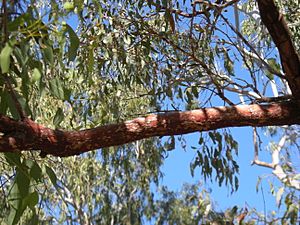Red-bark bloodwood facts for kids
Quick facts for kids Red-bark bloodwood |
|
|---|---|
 |
|
| Scientific classification | |
| Genus: |
Corymbia
|
| Species: |
erythrophloia
|
| Synonyms | |
|
Eucalyptus erythrophloia Blakely |
|
The Red-bark bloodwood (Corymbia erythrophloia) is a special type of tree. It is also known by other names like red bloodwood or gum-topped bloodwood. This tree is found only in Queensland, Australia. It has rough bark on its trunk and branches. Its leaves are shaped like eggs or spears. The tree produces creamy white flowers and round, urn-shaped fruits.
Contents
What Does the Red-bark Bloodwood Look Like?
This tree usually grows to about 15 meters (50 feet) tall. It has bark that can be red-brown, dull grey, or pink. This bark stays on the trunk and lower branches. The bark peels off in small, flat pieces, making the tree look patchy.
Leaves and Flowers
Young plants have leaves that are oval or egg-shaped. These leaves are about 5.5 to 12.5 centimeters (2 to 5 inches) long. As the tree grows, its adult leaves become more spear-shaped. They are usually dull grey-green on both sides. These adult leaves can be 9 to 23.6 centimeters (3.5 to 9 inches) long.
The flowers grow in groups of seven at the ends of the branches. Each flower bud is oval or pear-shaped. The Red-bark bloodwood blooms between January and April. Its flowers are a lovely creamy white color.
Fruit and Seeds
After the flowers, the tree produces woody fruits. These fruits are shaped like an urn or are almost round. They are about 1.1 to 2.1 centimeters (0.4 to 0.8 inches) long. Inside the fruits are reddish-brown seeds. These seeds are shaped like a boat or an oval and have a small wing on one end.
Where Does the Red-bark Bloodwood Grow?
The Red-bark bloodwood tree lives along the east coast of Queensland, Australia. You can find it as far north as Cooktown on the Cape York Peninsula. Its range also stretches west towards the Gulf of Carpentaria. The tree grows south to Hervey Bay. There is even a small group of these trees west of Brisbane.
Habitat and Soil
These trees prefer grassy woodlands or low, rolling hills. They grow well in clayey or stony soils. These soils often come from volcanic rock. You might often see the Red-bark bloodwood growing near other trees. These include the mountain coolibah and the Silver-leaved ironbark.
How is the Red-bark Bloodwood Protected?
The Queensland Government has a law called the Nature Conservation Act 1992. Under this law, the Red-bark bloodwood is listed as being of "least concern." This means that the tree is not currently in danger of disappearing.
Growing Red-bark Bloodwood in Gardens
People can grow the Red-bark bloodwood as a shade tree in their gardens. Birds love to visit these trees. They can handle hot sun and dry soils. The soil can be regular garden soil or richer soil. It can be clayey and slightly acidic to slightly alkaline. Gardeners sometimes prune these trees. They might keep one main trunk or allow several well-spaced trunks to grow.




